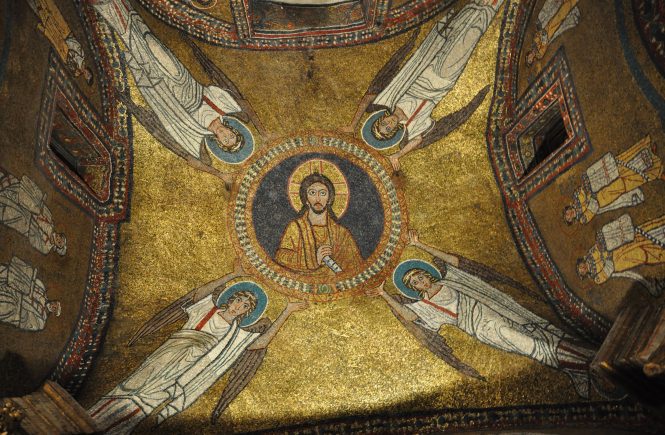Over the years, I have heard a lot of misconceptions about ancient Rome (and ancient Romans). From guidebooks. From tourists. Even from (some) tour guides.
My favorite myth about ancient Rome might be what I spotted in the Fodor’s Rome guidebook: The holes in the Colosseum come from the fact that it was shelled by Nazis. WTF? That’s just false. Thankfully, I later became a contributor for Fodor’s… so it’s one error that was removed starting in the 2012 edition.

Still, lots of other misconceptions are hanging around — and way harder to correct. Here are two that I find most irritating, and what the truth is behind them.
Misconception #1: Ancient Romans had very short lives, and if you made it to 35, you were old
I can’t tell you how many times I’ve heard this: “The life expectancy of the average Roman was 35.” What people, including many tour guides, usually draw from this is that 30- and 40-something Romans must have been very venerable indeed.
Here’s the problem. Aside from the fact that the data is terrible, this 35-year life expectancy is the average. Meaning it factors in the ancient world’s very high child mortality rate: Up to half of all Roman kids died before the age of 10. If you did reach 10, you could expect to live into your 40s or 50s, at least. Then there’s all the Roman men who died in military service… and the women who died in childbirth.
If you jumped through those hoops and survived your teens, 20s, and 30s, you’d have no reason to think you wouldn’t lead a nice, long life. In fact, those who reached the age of 60 would, on average, die after their 70th birthdays.
So no, someone at 35 wouldn’t have been seen as an “old person.” “From around the first century B.C. onwards, the age of 60 or 65 was commonly mentioned as the threshold of old age,” writes Karen Cokayne in her book Experiencing Old Age in Ancient Rome. That’s also the age when you got out of previous public obligations, like jury duty (yay!). And if everyone was dead in their 30s, how would justice ever have been served? Exactly.
For more, don’t miss my story written in October 2018 for BBC Future: Do we really live longer than our ancestors?
In other words: In the ancient world, child mortality sucked. But if they survived their childhood, childbirth, and military service, Romans could expect to live as long as we do today.
Misconception #2: Ancient Roman women had, like, no rights whatsoever
Let me make one thing clear: In no way would I rather be an ancient Roman woman than an American/Italian one (although, as a huge history nerd, making the trade for the chance to see the empire in its glory would be tempting…). But I might rather be a woman in ancient Rome than, I don’t know, a 21st-century woman in some other countries in the world.
First, the bad news: Ancient Roman women were citizens, but they couldn’t vote or hold political office. (Like America less than 100 years ago). And, technically, their father held patria potestas, or ultimate life-and-death power, over them until they died. (Eek!).
Still, some other things might surprise you. Ancient Roman women:
- could own property, engage in business, and loan money
- served as some of the empire’s most important priests (think: the Vestal Virgins, who weren’t under their father’s technical authority and who, thanks to those vows of chastity, didn’t have the usual obligation to marry and raise children)
- had the legal right to split their father’s property, 50-50, with their brothers
- fought as gladiators (…a rare occurrence, but it did happen!)
- went to public primary schools, and either received the same education as, or learned alongside, the boys
- worked out in gyms and may have participated in athletic contests (see the photo at top!)
In other words: Men and women were hardly equal in ancient Roman society. But, compared to other ancient societies — and even to some modern ones — Roman women had it pretty well.
Intrigued? Here’s some further reading:
Daily Life in the Roman City: Rome, Pompeii, and Ostia, a close look at the inner workings of urban Roman life
Ancient Rome: The Autobiography, an entertaining look at what it would have been like to live in ancient Roman times
Roman Women (Cambridge Introduction to Roman Civilization), a great, comprehensive, and easy-to-read overview of women’s roles in ancient Roman society
Rome’s Vestal Virgins, a thorough, and fascinating, look at the cult of Rome’s most powerful priestesses
Roman Women, a collection of essays about Roman women who were active in politics, theater, culture, and religion
Experiencing Old Age in Ancient Rome, on how Romans experienced and dealt with aging
Also: Rome’s most cutting-edge ancient site, 11 etiquette mistakes not to make at an Italian meal and can Rome’s ancient world be saved? (my 2016 video with the BBC).
If you liked this post, you’ll love The Revealed Rome Handbook: Tips and Tricks for Exploring the Eternal City, available for purchase on Amazon or through my site here! I’m also free for one-on-one consulting sessions to help plan your Italy trip.





